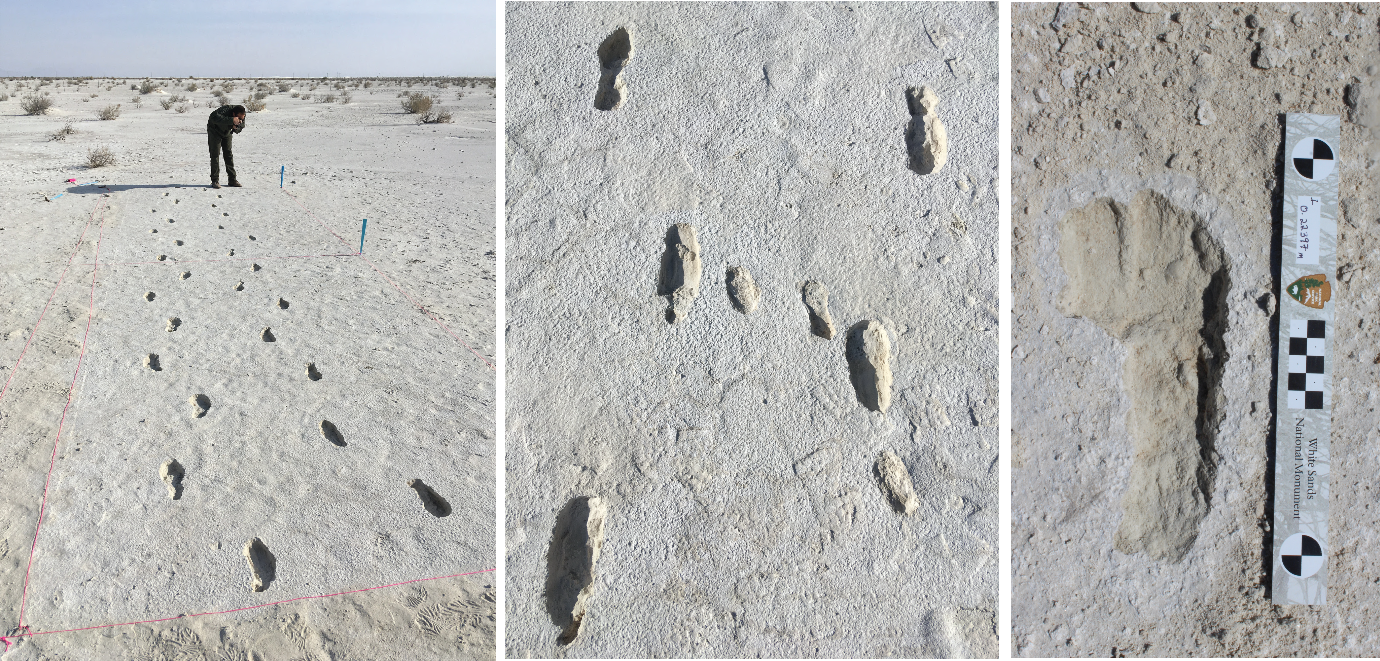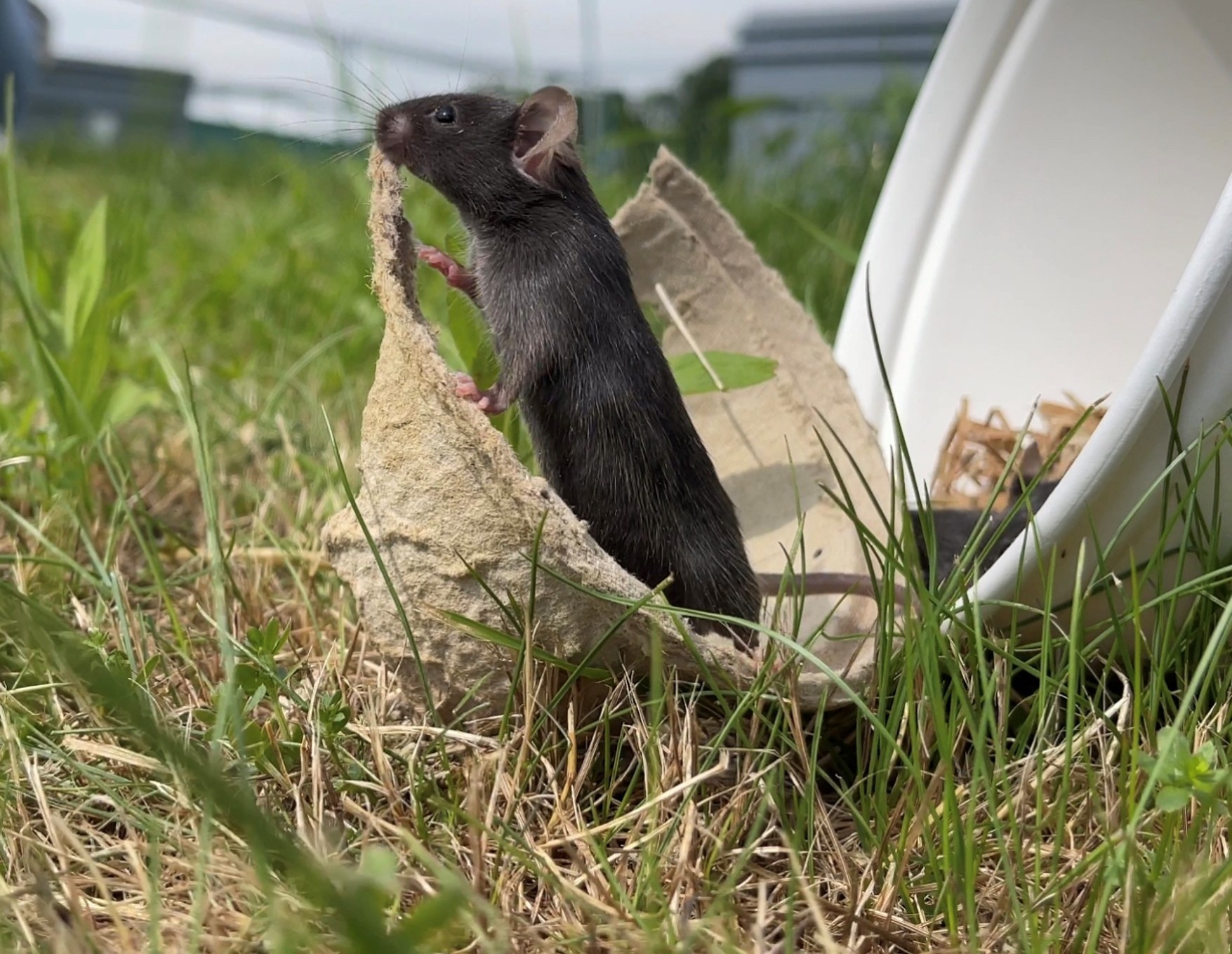The snowy gypsum sands of New Mexico are an archive of feet. Thousands of fossilized footprints line the edges of an ancient lake, traces of humans, mammoths, and giant ground sloths. The trails are remarkable, preserving the stories of individual people who lived in the Ice Age. One set of adult footprints covers nearly a mile, occasionally accompanied by the footprints of a toddler, suggesting the person carried the child as they walked. Other smaller prints appear to be from kids, splashing in puddles.
The ancient, dried-up lake now resides within White Sands National Park. In 2009, while helping search for a child missing in the park, a resource program manager for the park, David Bustos, discovered the footprints. (The child was found safe!) As Bustos and a team of researchers began excavating the site, they found thousands of human footprints across the park. In 2021, they published their analysis of the footprints in paper in the journal Science, claiming several of the human footprints were left about 21,000 to 23,000 years ago. These claims caused a stir in the field of archaeology, which largely maintained that humans only migrated to North and South America at the end of the last ice age, around 13,000 years ago. Tracks this old would rewrite the history of the first people in the Americas. But many outside researchers were loudly skeptical and remained unconvinced by the new claims, calling for more tests, more evidence, more proof.
Now, the original group of researchers have done exactly that, and published their robust additional analysis this week, once again in Science. Surprising no one, some skeptics remain skeptical. This saga over ancient feet has raised some evergreen questions about science. It's one thing to date a fossil; but how do you date a footprint? How much consensus does one need to actually settle a scientific debate? Will the White Sands tracks ever get a page on wikiFeet? Strap on your Tevas, for I, your Ancient Feet correspondent, will explain all.
Where did that 13,000-year date come from? And why do scientists care so much about when people first came to the Americas?
For decades, scientists pointed to a series of fluted, leaf-like spearheads called Clovis points that date to around 13,500 years ago. The blades are named after the city of Clovis, New Mexico, where they were first discovered in 1929. Scientists considered the Clovis people to be the first humans to arrive in the Americas.
But this "Clovis first" hypothesis has acted as a firewall against the claims of Indigenous archaeologists and communities that submitted claims of Indigenous life dating back years before Clovis, as Nick Martin wrote in an essay for High Country News. He points to the work of Paulette Steeves, a Cree-Métis archaeologist who argues that humans were present in North America up to 200,000 years ago. "This discovery and the knowledge accompanying it, you see, is entirely owned and framed by people who, in the grand scheme of history, have only known this land for a blink of time," Martin writes. "Apparently, they can’t help but regard the footprints they discovered, not as Indigenous, but merely as evidence."
So even if you are not naturally inclined to wonder about the "peopling" (a word that will never not seem made-up to me) of the Americas, these debates tie into larger issues of western systems of validation dismissing Indigenous knowledge as inferior, incomplete, or political—critiques that surely could not be applied to western science.
If a footprint doesn't have any organic material (e.g. feet) left in it, how can you tell how old it is?
A footprint is an example of a trace fossil, an imprint left by an organism. In their first paper on the White Sands footprints, the scientists relied on ancient seeds of a plant called spiral ditchgrass, or Ruppia cirrhosa, to date the prints. When the researchers were excavating the prints, they often found ancient ditchgrass seeds. They measured the carbon in the seeds to learn their age (carbon decays through time at a constant rate, so scientists can date once-living objects by measuring how much carbon remains inside them.) The analysis found the grass had grown thousands of years before the end of the Ice Age—far earlier than they suspected. To get a better estimate, the researchers took samples of ditchgrass seeds in the sediment layers directly above and beneath the footprints, measured their carbon, and deduced the footprints were made about 21,130 to 22,860 years ago.
According to the critics, the carbon in the seeds was not a foolproof stand-in for the date of the footprints. Aquatic plants can absorb much older carbon from lake water or groundwater that may not have been exposed to the atmosphere for thousands of years. So, the critics argued, this may have made the ditchgrass seeds appear much older than they actually are.
So what did the scientists do differently in the new paper?
Great question! This time, the scientists used two new methods to date the footprints. First, they dated the carbon in pollen grains found in the same sediment layers as the footprints. The non-aquatic pollen would not have been affected by the same concerns of older-carbon contamination that muddied the ditchgrass dating. So you may be wondering, why not date pollen in the first place? Unsurprisingly, extracting pollen grains from solid rock is an extremely painstaking process, involving breaking down slabs of rock into tiny cubes, separating extremely tiny grains of pollen, and then sampling every grain to see if it was heavy enough to meet the requirements for carbon dating. The researchers isolated 75,000 pollen grains, which is colloquially known as a helluva lotta pollen grains. But the largest grains, which mostly came from pine, dated to 22,600 to 23,400 years ago—a match!
The second method, involving crystals, was called "optically stimulated luminescence." This method, though sounding way cooler, I understand far less. Essentially the scientists measured the energy built up in quartz crystals inside the sediments of White Sands, which should reveal how long ago the crystals were exposed to sunlight and heat. If you asked me any more questions about this method, I simply couldn't answer them. But if you want to learn more about this process, which involves "hammering tubes" and then measuring "the almost imperceptible glow of quartz grains," read this story in Scientific American.
What are the haters—ahem, the critics—saying now? Is the debate settled?
All the haters have yet to become waiters. Loren Davis, an archaeologist at Oregon State University, told The New York Times that optically stimulated luminescence can lack precision, and noted the researchers only dated one sediment layer with this method. “We just have to acknowledge that none of these approaches are perfect,” Davis told The Times. This is certainly a fair criticism; few methods in any science that deals with deep history are perfect. But with three alternate lines of evidence—the ditchgrass seeds, the pollen, and the luminescent quartz—many outside researchers say they are, at least, reasonably convinced that humans were in North America more than 20,000 years ago.
Would the first humans in the Americas have been okay with showing their feet, or at least prints of them, for free?
Some facets of history will forever remain a mystery to us, and there are endless questions we will never be able to ask our ancestors. If you would like to see videos of archaeologists gently, loving scraping sediment out of some of these footprints under the pastel skies of the desert, the National Park Service has 17 minutes and 33 seconds of free feet content here. We will not judge you.






